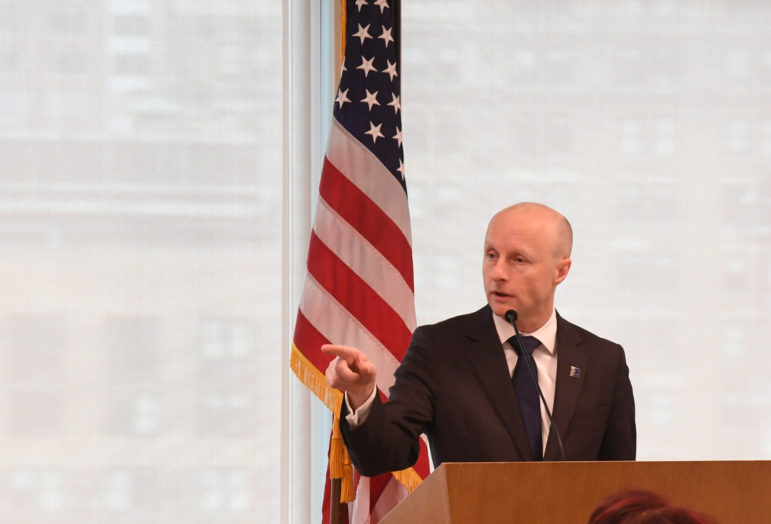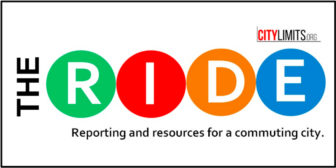
MTA
New York City Transit President Andy Byford said last month that fare-beating was ‘an increasing problem’ for the MTA: Turnstile jumpers had cost the cash-strapped transit agency an estimated $215 million in 2018, he said.
Like its shifting policies on marijuana policing, New York is moving in the direction of decriminalizing fare evasion. Last year, the Manhattan district attorney’s office announced it would stop prosecuting most cases , and the NYPD in August adjusted its policy in favor of issuing summonses instead of arrests in most instances.
These changes, driven by the belief that fewer arrests will free up resources that could be better used elsewhere, is a stark contrast to the “broken windows” policing so central to New York City in the 1990s. Advocates have long argued that that kind of aggressive enforcement of low-level offenses, like turnstile jumping, is targeted disproportionately against people of color, not to mention the potentially life-altering impact an arrest can have on a person—an overly punitive consequence for the theft of $2.75, they say.
“Transit costs money—it costs a ton of money to run the MTA—and there’s a reason there are penalties for all of these: for jumping the turnstile, for not paying the toll, for not paying for parking meters,” says Harold Stolper, an economist with the Community Service Society who’s authored several reports on turnstile enforcement and transit. “But the point of the penalty should be to deter fare evasion, not to unduly punish people based on a lack of resources.”
Recent NYPD transit statistics reflect the city’s changing policies towards fare beaters, as arrests are down significantly. In December of 2018, police made 316 arrests for “theft of services” (TOS)—the charge for the offense of skipping the fare—down from 976 during the same month of 2017, MTA documents show. Fare evasion arrests for the whole year also dropped sharply, with 5,905 total arrests in 2018 compared to 18,040 the year before, according to numbers provided by the NYPD.
While turnstile jumping arrests were down in December, summonses for TOS were up: police issued 5,945 Transit Adjudication Bureau (TAB) summonses that month, compared to 3,184 during the same period last year. However, summonses were down slightly in 2018 overall, with 53,141 TAB summonses issued for fare evasion last year compared to 55,323 in 2017.
The NYPD also gave out 2,145 criminal court summonses to fare beaters in 2018, as part of the police department’s policy shift this summer to no longer arrest evaders who have open summonses for low-level offenses. Those who receive a criminal court summons are required to resolve it in criminal court, as the name implies—as opposed to doing so in the MTA’s civilly-based TAB—but most are not formally arrested or fingerprinted.
Get the best of City Limits news in your inbox.
Select any of our free weekly newsletters and stay informed on the latest policy-focused, independent news.
A police officer may opt to issue a criminal court summons in lieu of a TAB summons if the fare evader in question is deemed a “TAB recidivist,” meaning they’ve been hit with three or more TAB violations in the last two years, or if they have three or more unpaid TAB summonses from within the last eight years, according to NYPD policy. Police can still arrest fare evaders, however, if they’re categorized as “transit offenders”—if they’re on parole or probation, have had three or more unsealed fare evasion arrests in the last three years, or if they’ve previously been arrested in the transit system for another, more serious crime.
“In partnership with New York City Transit, we are exploring different ways to change behavior of those who seek to evade the fare at turnstiles, and this is one of the strategies we’re piloting,” the NYPD told City Limits in a statement.
Fewer busts = more jumping?
During an MTA board meeting in December, New York City Transit President Andy Byford pointed to these shifts in fare evasion enforcement policy as one of the many factors that may have led to what he says was a steep rise in turnstile jumping last year.
“What’s striking is the correlation between that decision being made, the corresponding decline in arrests and other enforcement activity, and an increase in evasion,” he said.
Turnstile jumpers had cost the cash-strapped transit agency an estimated $215 million in 2018, he said.
The Long-Shot Case for Making NYC Public Transit Free
In response, the MTA turned emergency-door alarms back on recently in a handful of stations at the request of the NYPD, trying to discourage scofflaws from entering the system through those portals.
The MTA’s other recent tactics include posting anti-fare evasion posters throughout the system, deploying more “Eagle Teams” to enforce payments on bus routes, and randomly setting up “revenue protection blockades” in subway stations, staffed by transit officials, to discourage fare beaters, Byford said.
Byford has mentioned the idea of seeking support from lawmakers to raise the fine for fare evasion—currently $100—while at least one MTA board member last week called on his colleagues to come up with a more formalized plan to try and recover some of the revenue lost to turnstile jumpers.
“We have to address the fare evasion issue,” Larry Schwartz said during Thursday’s board meeting, where members convened to discuss a potential fare hike— needed, the MTA says, to cover rising operating costs and declining revenue. “That’s a $220 million revenue loss to the agency.”
MTA’s claims questioned
But critics say they’ve seen no evidence that fare evaders have been emboldened by the drop in arrests or the Manhattan DA’s decision not to prosecute.
“It’s hard to believe that that switch would lead to a dramatic increase in fare evasion,” says Stolper. Police are still stopping fare beaters and issuing summonses, and the cost of those stops isn’t cheap: The civil fine for theft of services is $100, or 36 times the $2.75 the offender swiped at the turnstile, and more than what a driver would be fined for failing to pay their parking meter, according to a CSS report.
“People are making hard choices, living paycheck to paycheck, and sometimes they take the risk to jump the turnstile. And [$100], that’s still a big risk for them,” Stolper says.
Some experts have questioned the validity of the MTA’s fare evasion numbers—the agency says an estimated 348,000 subway and 208,000 bus riders skipped payment each day during the third quarter of 2018—and others have accused the transit authority of focusing on fare beaters to distract from its own mismanagement issues.
“Not prosecuting people for the penal law theft of services does not equal, ‘It’s a free for all,'” says Council Member Rory Lancman, who chairs the council’s justice committee. “How about you provide better service—maybe people will be less resentful of paying the fare.”
Lancman sponsored a law that was passed in 2017 which requires the NYPD regularly release data on its fare-evasion enforcement actions. His office, along with CSS, filed a lawsuit last fall accusing the NYPD of failing to comply with the law, saying the police department is still withholding much of the required information.
In October, CSS released an analysis of the numbers the police department has shared so far and found that while arrests and overall fare enforcement actions were down, they were still showing a racial bias: During the second quarter of 2018, people of color accounted for almost 94 percent of fare evasion arrests for which race was known, the report says.
“Even when we laudably reduce the number of arrests and entanglements in the criminal just system, we are not making progress in combating the disproportionate application of the criminal justice system,” says Lancman.
Last week, Byford acknowledged the fear of what increased enforcement at the turnstile could mean for people of color.
“We are aware of the sensitivities of this,” he said at an MTA committee meeting on Tuesday, adding that he’s recently met with Manhattan DA Cy Vance to discuss the issue. “We were on the same page about not criminalizing people, but about having the right interventions.”
Still, Byford said fare evasion still needs to be dealt with somehow.
“We’re not going to ignore it, because I don’t think it’s right to the fare-paying customers that we do,” he said.










One thought on “Does Less Policing = More Fare Beating on New York City Subways?”
Pingback: Fare evasion prosecutions fall 96% in New York - Trainsfare